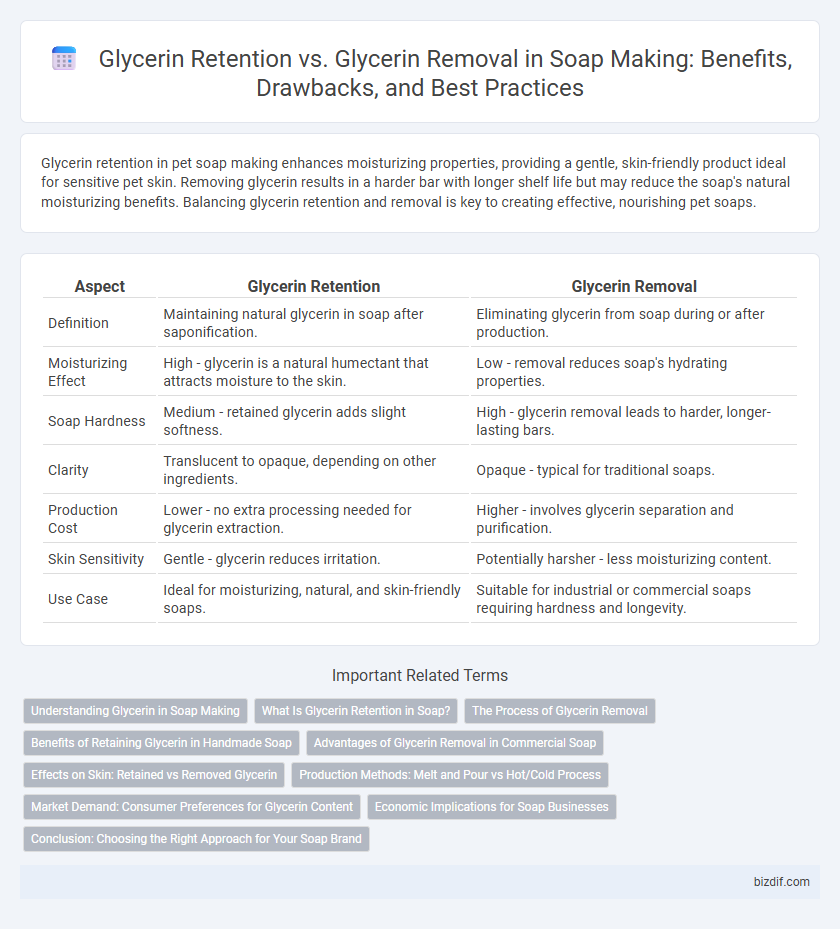Glycerin retention in pet soap making enhances moisturizing properties, providing a gentle, skin-friendly product ideal for sensitive pet skin. Removing glycerin results in a harder bar with longer shelf life but may reduce the soap's natural moisturizing benefits. Balancing glycerin retention and removal is key to creating effective, nourishing pet soaps.
Table of Comparison
| Aspect | Glycerin Retention | Glycerin Removal |
|---|---|---|
| Definition | Maintaining natural glycerin in soap after saponification. | Eliminating glycerin from soap during or after production. |
| Moisturizing Effect | High - glycerin is a natural humectant that attracts moisture to the skin. | Low - removal reduces soap's hydrating properties. |
| Soap Hardness | Medium - retained glycerin adds slight softness. | High - glycerin removal leads to harder, longer-lasting bars. |
| Clarity | Translucent to opaque, depending on other ingredients. | Opaque - typical for traditional soaps. |
| Production Cost | Lower - no extra processing needed for glycerin extraction. | Higher - involves glycerin separation and purification. |
| Skin Sensitivity | Gentle - glycerin reduces irritation. | Potentially harsher - less moisturizing content. |
| Use Case | Ideal for moisturizing, natural, and skin-friendly soaps. | Suitable for industrial or commercial soaps requiring hardness and longevity. |
Understanding Glycerin in Soap Making
Glycerin is a valuable humectant naturally produced during the saponification process in soap making, which helps retain moisture and enhances skin hydration. Retaining glycerin in soap results in a moisturizing bar that is gentle and nourishing, while glycerin removal, often done to create a harder, longer-lasting bar, can reduce these skin-beneficial properties. Understanding the balance between glycerin retention and removal is crucial for soap makers aiming to produce either a gentle, moisturizing soap or a durable, aesthetically appealing product.
What Is Glycerin Retention in Soap?
Glycerin retention in soap refers to the preservation of natural glycerin produced during the saponification process, which acts as a humectant to attract moisture and enhance skin hydration. Unlike glycerin removal, which involves extracting glycerin to sell separately or use in other products, glycerin-retained soaps maintain their moisturizing properties and are gentler on the skin. This makes glycerin retention a key factor in producing high-quality, moisturizing soap bars favored in both handcrafted and commercial soap making.
The Process of Glycerin Removal
The process of glycerin removal in soap making typically involves washing the soap with water to leach out the naturally occurring glycerin, which is a humectant beneficial for skin hydration. Manufacturers aiming for a harder, less moisturizing bar often use solvent extraction or prolonged curing techniques to reduce glycerin content effectively. Removing glycerin changes the soap's texture, making it more abrasive but extending its shelf life by reducing its attraction to moisture.
Benefits of Retaining Glycerin in Handmade Soap
Retaining glycerin in handmade soap enhances its moisturizing properties, as glycerin acts as a natural humectant that attracts and retains moisture on the skin. This results in a gentler, more hydrating soap compared to commercial soaps where glycerin is often removed for use in other products. Preserving glycerin also contributes to a smoother, creamier lather and improves the overall skin conditioning benefits of the soap.
Advantages of Glycerin Removal in Commercial Soap
Glycerin removal in commercial soap production enhances product clarity and firmness, appealing particularly to consumers who prefer transparent or bar soaps with a consistent texture. Removing glycerin reduces the soap's moisture content, prolonging shelf life and minimizing the risk of soap sweating or becoming sticky in humid environments. This process also allows manufacturers to recycle glycerin for use in cosmetics and other industries, improving overall resource efficiency.
Effects on Skin: Retained vs Removed Glycerin
Retained glycerin in soap enhances skin hydration by attracting moisture, promoting smoothness and preventing dryness. Removing glycerin often results in a harsher soap that can strip natural oils, causing irritation and increased skin dryness. Soaps with glycerin retention support better skin barrier function and overall skin health compared to those with glycerin removed.
Production Methods: Melt and Pour vs Hot/Cold Process
Melt and Pour soap production retains glycerin naturally due to its pre-made soap base, ensuring moisturizing properties remain intact. In contrast, Hot and Cold Process methods often result in glycerin removal or separation during saponification and curing, requiring careful handling to preserve glycerin content. Understanding these production differences is crucial for soap makers aiming for specific moisturizing qualities in their final products.
Market Demand: Consumer Preferences for Glycerin Content
Consumers increasingly prefer soaps with high glycerin content due to its moisturizing and skin-nourishing properties, driving market demand for glycerin-retentive soap formulations. Products that retain natural glycerin provide superior hydration and gentle cleansing, appealing to health-conscious buyers and those with sensitive skin. Conversely, soaps with glycerin removal often fail to meet these preferences, limiting their appeal in premium and natural soap market segments.
Economic Implications for Soap Businesses
Glycerin retention in soap manufacturing enhances product moisturizing qualities, allowing businesses to market premium soaps that justify higher pricing and improve customer loyalty. Conversely, glycerin removal increases immediate production yields by selling glycerin as a separate commodity, offering an additional revenue stream but potentially reducing soap moisturizing value. Balancing glycerin retention and removal strategies directly impacts profitability, with decisions dependent on market demand, production costs, and brand positioning within the competitive soap industry.
Conclusion: Choosing the Right Approach for Your Soap Brand
Prioritizing glycerin retention in soap making enhances moisturizing properties, appealing to consumers seeking skin-nourishing benefits and allowing brands to market natural hydration. Opting for glycerin removal yields a harder bar with longer shelf life, ideal for mass production and cost efficiency, though it sacrifices some skin-conditioning qualities. Balancing glycerin levels based on target market preferences ensures a competitive edge and aligns product attributes with brand identity.
Glycerin Retention vs Glycerin Removal Infographic

 bizdif.com
bizdif.com